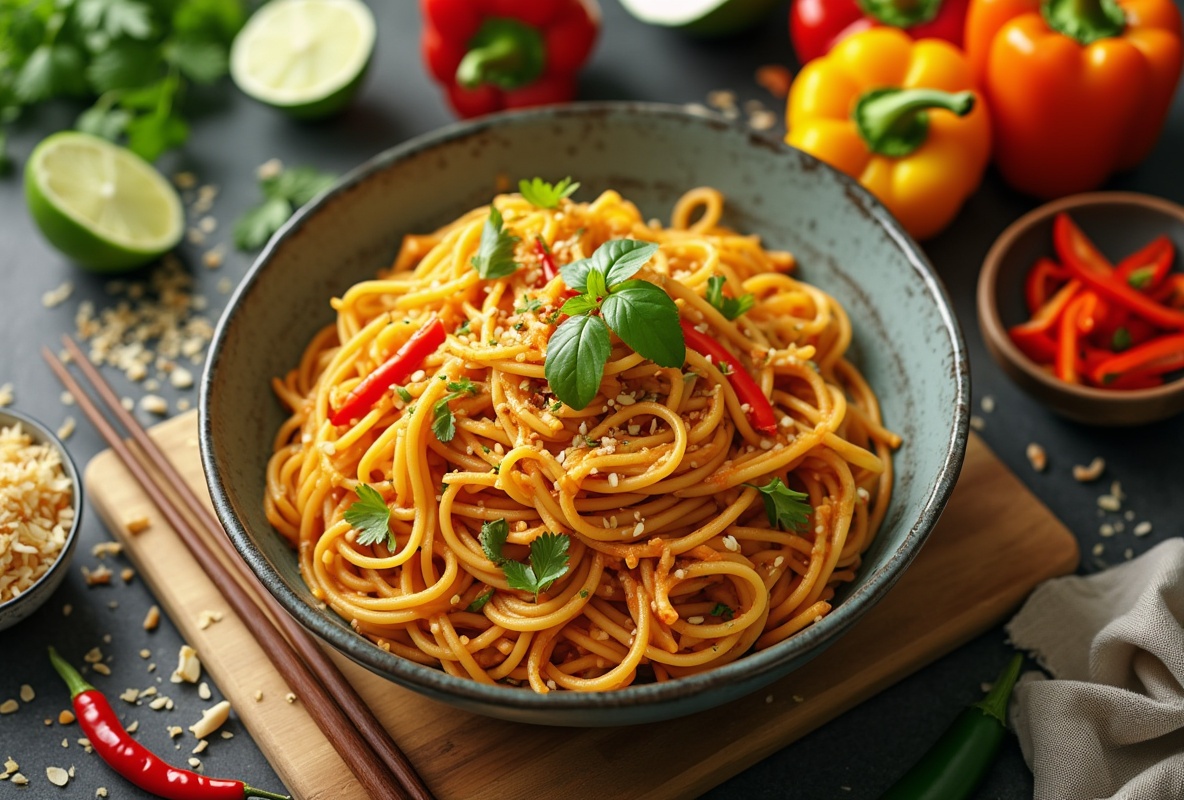Exploring the Fusion: Curry Pasta and Its Unique Ingredients
Creating the perfect Curry Pasta Ingredients List allows us to dive into a delicious fusion of flavors, marrying the fragrant spices of Indian cuisine with the comforting texture of Italian pasta. This delightful dish captures the imagination and captivates the palate, using a whole array of unique components. From rich curry powders to earthy herbs and vibrant vegetables, every element plays a crucial role. Join me as we explore how to blend these diverse cultures into a single, mouthwatering dish.
Essential Spices and Herbs for Curry Pasta
When crafting a delicious Thai Curry Pasta, the spices and herbs used can make all the difference. Imagine infusing your dish with the fragrance of coriander and cumin, both of which bring that signature earthiness. I often find that a hint of turmeric adds a warm color and subtle flavor that pairs beautifully with the dish’s overall taste. Curry leaves are a must, lending an authentic touch that elevates your pasta to new heights. Don’t forget the ginger and garlic; they provide a zesty kick that complements the creamy curry sauce perfectly. If you love a bit of heat, chilies can add a fiery element to your dish. And, of course, a sprinkle of cilantro just before serving offers a fresh, vibrant finish. By blending these essential spices and herbs, you’ll create a curry pasta that’s rich, aromatic, and full of life!
Key Components: Pasta Types for Your Dish
When creating a delightful curry pasta, choosing the right pasta type is crucial. In my experience, the choice of pasta can significantly influence the texture and absorbency of the flavors. For the Curry Pasta Ingredients List, you can play with a variety of pasta types to find the perfect match for your Thai curry pasta. Spaghetti and linguine are classics that provide a satisfying chew and hold the sauce well. For a twist, try using fusilli or rotini, which have grooves that beautifully capture the richness of Thai or Indian-inspired curry sauces. If you’re aiming for a more hearty dish, consider penne or rigatoni, which offer a thicker bite and substantial feel. Flat broad noodles such as tagliatelle can also work wonders, providing ample surface area to soak up a creamy coconut curry. Experimenting with different pasta types like farfalle or even soba can open up new dimensions in your dish, turning your curry pasta into an exciting culinary adventure.
Proteins to Elevate Your Curry Pasta Flavor
When it comes to enhancing the flavor of your Thai Curry Pasta, selecting the right proteins can make a world of difference. As you might agree, chicken is a classic choice, bringing tenderness and a mild flavor that pairs beautifully with aromatic curry spices. Seafood lovers might opt for shrimp or scallops, which add a touch of elegance and a subtle sweetness to the dish. For those preferring a plant-based option, tofu or chickpeas are fantastic choices, offering a delightful texture and earthy taste that harmonizes well with the rich curry sauce. If you’re exploring more vegetarian options, you can refer to vegan meatloaf cranberry orange relish for plant-based protein inspiration. Adding proteins not only boosts the nutritional value of your meal but also provides a satisfying contrast to the creamy, spicy elements of the curry. Whether you’re a fan of meat or favor vegetarian alternatives, integrating these protein sources will help you craft a memorable and delectable Thai Curry Pasta dish.
Vegetables: Adding Color and Texture to Your Dish
When I’m crafting a delightful Thai Curry Pasta, I love to experiment with an array of vibrant vegetables. They not only infuse the dish with color but also add a satisfying texture that elevates the overall experience. Fresh bell peppers, with their crisp bite, are a fantastic choice, while snap peas offer a touch of sweetness. Broccoli florets and carrot ribbons bring a pleasing balance, providing a mix of earthiness and subtle sweetness. For a more aromatic twist, I like to incorporate fresh Thai basil leaves, which complement the rich spices and creamy coconut curry. These ingredients, combined with a symphony of colors and flavors, make the pasta dish truly irresistible. Personalizing your curry pasta with seasonal produce can also be a delightful way to experiment with local ingredients, ensuring that every bite is both satisfying and fresh. If you’re interested in combining vegetables with other creative dishes, check out how vibrant ingredients are used in daily chickpea salad benefits. Embrace the variety and find your perfect vegetable mix for a wholesome, flavorful meal.
Complementary Sauces and Their Role in Flavoring
When crafting the perfect Thai Curry Pasta, the sauce you choose is crucial. It not only ties the dish together but also enhances the flavors of every ingredient. Imagine the rich creaminess of coconut milk intertwining with aromatic spices; it’s pure magic. You might consider a red curry sauce or a green curry base depending on your taste preferences. These sauces bring a spice-filled harmony that complements tender pieces of chicken or tofu. Adding subtle hints of lime juice or fish sauce gives your dish that authentic Thai essence. Balancing these flavors with a touch of sugar or tamarind paste can elevate the sauce to new culinary heights. Remember, the sauce isn’t just a backdrop; it’s what makes every bite of your curry pasta burst with flavor, creating an unforgettable fusion of Italian and Thai cuisines.
Crafting the Perfect Curry Pasta Ingredients List
Creating the perfect Thai curry pasta is an art that lies in balancing flavors with diverse ingredients. Firstly, choosing the right pasta type is crucial. You might opt for classic spaghetti, fettuccine, or even rice noodles for an Asian twist. The spices and herbs like turmeric, cumin, and lemongrass play a significant role in enriching the aroma. Don’t forget to include aromatic veggies such as bell peppers and onions, which add both color and texture.
For your protein, consider using chicken, shrimp, or tofu to add substance and satisfy every palate. The choice of sauce is equally important – a creamy coconut milk or a spicy red curry paste can add a delightful depth to the dish. Remember, each component harmonizes to form a delightful fusion in your curry pasta. Therefore, crafting an ingredients list that combines all these elements ensures you capture the essence of a delectable Thai curry pasta.
Frequently Asked Questions
How can I add a burst of flavor to my curry pasta?
To elevate the flavor of your curry pasta, use a mix of fresh herbs like cilantro and basil, and spices like cumin and coriander. Adding a splash of lime juice at the end can give a refreshing kick.
What type of pasta works best for curry pasta?
For curry pasta, try using penne or fusilli. Their shapes hold sauce well, ensuring each bite is flavorful. Spaghetti can work too, if you prefer a more classic pasta experience.
Can I make curry pasta with different proteins?
Yes, you can easily customize curry pasta with proteins like chicken, tofu, or shrimp. Each option offers a unique twist and depth to the dish while keeping it hearty.
What kind of vegetables should I add to curry pasta?
Vegetables like bell peppers, peas, and spinach not only add vibrant colors to your curry pasta but also bring essential nutrients and texture, making the dish wholesome and satisfying.
Are there any sauces that complement curry pasta well?
Absolutely, sauces like coconut milk or a simple tomato-based curry sauce can complement and enhance the flavors of your curry pasta, offering richness and a hint of sweetness.

